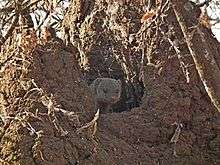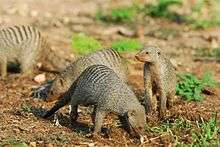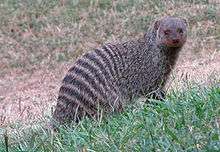Banded mongoose
| Banded mongoose | |
|---|---|
 | |
| Maasai Mara, Kenya | |
| Scientific classification | |
| Kingdom: | Animalia |
| Phylum: | Chordata |
| Class: | Mammalia |
| Order: | Carnivora |
| Family: | Herpestidae |
| Genus: | Mungos |
| Species: | M. mungo |
| Binomial name | |
| Mungos mungo Gmelin, 1788 | |
 | |
| Banded mongoose range | |
The banded mongoose (Mungos mungo) is a mongoose commonly found in the central and eastern parts of Africa. It lives in savannas, open forests and grasslands and feeds primarily on beetles and millipedes. Mongooses use various types of dens for shelter including termite mounds. While most mongoose species live solitary lives, the banded mongoose live in colonies with a complex social structure.
Physical characteristics
The banded mongoose is a sturdy mongoose with a large head, small ears, short, muscular limbs and a long tail, almost as long as the rest of the body. Animals of wetter areas are larger and darker colored than animals of dryer regions. The abdominal part of the body is higher and rounder than the breast area. The rough fur is grayish brown and black, and there are several dark brown to black horizontal bars across the back. The limbs and snout are darker, while the underparts are lighter than the rest of the body. Banded mongooses have long strong claws that allow them to dig in the soil.
An adult animal can reach a length of 30 to 45 cm and a weight of 1.5 to 2.25 kg. The tail is 15 to 30 cm long.
Range and ecology
The banded mongoose is found in a large part of East, Southeast and South-Central Africa. There are also populations in the northern savannas of West Africa. The banded mongoose lives in savannas, open forests and grassland, especially near water, but also in dry, thorny bushland but not deserts. The species uses various types of dens for shelter, most commonly termite mounds.[2] They will also live in rock shelters, thickets, gullies, and warrens under bushes. Mongooses prefer multi-entranced termitaria with open thicket, averaging 4 m from the nearest shelter, located in semi-closed woodland.[3] In contrast to the den of the dwarf mongoose, banded mongoose dens are less dependent on vegetation cover and have more entrances.[3] Banded mongooses live in larger groups than dwarf mongooses and this more entrances means more members have access to the den and ventilation.[3] The development of agriculture in the continent has had a positive influence on the number of banded mongooses. The crops of the farmland serve as an extra food source.

Food and foraging
Banded mongoose feed primarily on insects, myriapods, small reptiles, and birds. Millipedes and beetles made of most of their diet,[2] but they also commonly eat ants, crickets, termites, grasshoppers, caterpillars and earwigs.[4][5] Other prey items of the mongoose includes frogs, lizards, small snakes, ground bird and the eggs of both birds and reptiles. On some occasions, mongooses will drink water from rain pools and lake shores.[4]
Banded mongoose forage in groups but each member searches for food alone.[4] They forage in the morning for several hours and then rest in the shade. They will usually forage again in the late afternoon. Mongooses use their sense of smell to locate their prey and dig them out with their long claws, both in holes in the ground and holes in trees. Mongoose will also frequent near the dung of large herbivores since they attract beetles.[4] Low grunts are produced every few seconds for communication. Mongoose also feed individually and are not cooperative feeders. When hunting prey that secrete toxins, mongooses will roll them on the ground. Durable prey is thrown on hard surfaces.[6]
Social behavior
Banded mongooses live in mixed-sex groups of 7–40 individuals (average around 20).[7] Groups sleep together at night in underground dens, often abandoned termite mounds, and change dens frequently (every 2–3 days). When no refuge is available and hard-pressed by predators such as wild dogs, the group will form a compact arrangement in which they lie on each other with heads facing outwards and upwards.

There is generally no strict hierarchy in mongoose groups and aggression is low. Sometimes, mongoose may squabble over food. However, typically, the one who claims the food first wins. Most aggression and hierarchical behavior occurs between males when females are in oestrus. Female are usually not aggressive but do live in hierarchies based on age. The older females have earlier estrous periods and have larger litters.[7] When groups get too large, some females are forced out of the group by either older females or males. These females may form new groups with subordinate males.[8]

Relations between groups are highly aggressive and mongooses are sometimes killed and injured during intergroup encounters. Nevertheless, breeding females will often mate with males from a rival groups during fights.[9] Mongooses establish their territories with scent markings that may also serve as communication between those in the same group.[10] In the society of the banded mongoose there is a clear separation between mating rivals and territorial rivals. Individuals within groups are rivals for mates while those from neighboring groups are competitors for food and resources.[10]
Reproduction

Unlike most other social mongoose species, all females in a banded mongoose group can breed.[7] They all enter oestrus around 10 days after giving birth, and are guarded and mated by 1–3 dominant males.[7] The dominant males monitor the females and aggressively defend them from subordinates. While these males do most of the mating, the females often try to escape from them and mate with other males in the group. A dominant male will spend 2–3 days guarding each female.[7] A guarding male will snap at, lunge at or pounce on any males that come near.[7] A non-guarding male may follow a guarding male and his female and may face this aggression. Non-guarding males mate in a more secretive way.[7] This kind of "sneaking" behavior is similar to what subordinate males of the fish species Neolamprologus pulcher do; they also try to mate with females that are guarded by the dominant males.
Gestation is 60–70 days. In most breeding attempts, all females give birth either on the same day[7][11] or within a few days. Litters range 2–6 pups and average 4. For the first four weeks of life, pups stay in the dens where they form an exclusive relationship with a single helper or escort, whose genetic relationship with the pups is unknown. These helpers are generally young nonbreeding males or breeding females who have contributed to the current litter and they help to minimize competition over food allocation among pups.[12] During this time they are guarded by these helpers while the other group member go on their foraging trips.[13] After four weeks, the pups are able to go foraging themselves. Each pup is cared for by a single adult "escort" who helps the pup to find food and protects it from danger.[14] Pups become nutritionally independent at three months of age.
Inbreeding avoidance
Inbreeding depression is largely caused by the homozygous expression of deleterious recessive alleles.[15] Inbreeding depression appears to occur in banded mongooses as indicated by a decline in progeny body mass with increasing inbreeding coefficient.[16] This finding suggests that avoiding breeding with close relatives would be beneficial. Successfully breeding pairs were found to be less related than expected under random mating.[16] This mating bias appears to be driven by both male mate choice and female control of paternity. Both sexes of banded mongoose likely use kin discrimination to avoid inbreeding.[16]
Interspecies relations
In some locations (e.g., Kenya) banded mongooses have been found in close relationship with baboons. They forage together and probably enjoy greater security as a large group because of more eyes on the lookout for predators. The mongooses are handled by baboons of all ages and show no fear of such contact.
Banded mongooses have been observed removing ticks and other parasites from warthogs in Kenya[17] and Uganda.[18] The mongooses get food, while the warthogs get cleaned.
Status and abundance
Banded mongooses lives in many of Africa's protected areas.[1] The Serengeti of Tanzania, has a density of around 3 mongooses per km2.[19] In southern KwaZulu-Natal, South Africa, mongoose numbers are at a similar density at 2.4 km2.[20] Queen Elizabeth National Park has much higher mongoose densities at 18/km 2.[21] Overall the banded mongoose tends to be more abundant in the eastern and south-eastern areas of its range than in more western areas.
References
| Wikimedia Commons has media related to Mungos mungo. |
| Wikispecies has information related to: Mungos mungo |
- 1 2 Hoffmann, M. (2008). "Mungos mungo". IUCN Red List of Threatened Species. Version 2008. International Union for Conservation of Nature. Retrieved 22 March 2009. Database entry includes a brief justification of why this species is of least concern.
- 1 2 Neal, E. (1970). "The banded mongoose, Mungos mungo Gmelin." East African Wildlife Journal 8: 63-71.
- 1 2 3 Hiscocks, K., Perrin, M. R. (1991). "Den selection and use by dwarf mongooses and banded mongooses in South Africa." South African Journal of Wildlife Research 21(4): 119-122.
- 1 2 3 4 Rood, J. P. (1975). "Population dynamics and food habits of the banded mongoose." East African Journal of Wildlife 13: 89-111.
- ↑ Smithers, R.H.N (1971) The mammals of Botswana, National Museums of Rhodesia. 4:1-340.
- ↑ Simpson, C.D. (1964) "Notes on the banded mongoose, Mungos mungo (Gmelin)". Arnoldia, Rhodesia 1(19):1-8
- 1 2 3 4 5 6 7 8 CANT, M.A. (2000) Social control of reproduction in banded mongooses. Anim. Behav. 59:147-158
- ↑ CANT, M.A., OTALI, E. & MWANGUHYA, F. (2001). Eviction and dispersal in cooperatively breeding banded mongooses. J. Zool. 254:155-162
- ↑ CANT, M.A., OTALI, E. & MWANGUHYA, F. (2002). Fighting and mating between groups in cooperatively breeding banded mongooses. Ethology 108:541-555
- 1 2 Jordan, N.R., Mwanguhya, F., Kyabulima, S., Ruedi, P., and Cant, M.A. (2010) "Scent marking within and between groups in banded mongooses". Journal of Zoology 280:72-83.
- ↑ GILCHRIST, J.S. (2006). Female eviction, abortion and infanticide in the banded mongoose (Mungos mungo). Behav. Ecol. 17:664-669
- ↑ Bell, Mathew. "Cooperative Begging in Banded Mongoose Pups".
- ↑ CANT, M.A. (2003) Patterns of helping effort in cooperatively breeding banded mongooses. J. Zool. 259:115-119
- ↑ GILCHRIST, J.S. (2004). Pup escorting in the communal breeding banded mongoose: behavior benefits and maintenance. Behav. Ecol. 15:952-960
- ↑ Charlesworth D, Willis JH (2009). "The genetics of inbreeding depression". Nat. Rev. Genet. 10 (11): 783–96. doi:10.1038/nrg2664. PMID 19834483.
- 1 2 3 Sanderson JL, Wang J, Vitikainen EI, Cant MA, Nichols HJ (2015). "Banded mongooses avoid inbreeding when mating with members of the same natal group". Mol. Ecol. 24 (14): 3738–51. doi:10.1111/mec.13253. PMID 26095171.
- ↑ Warthog at Wildwatch.com
- ↑ Banded Brothers episode 1 at bbc.co.uk
- ↑ Waser, PM, LF Elliott, and SR Creel. 1995. "Habitat variation and viverrid demography". In ARE Sinclair and P Arcese (eds.) Serengeti II: Dynamics, Management and Conservation of an Ecosystem, University of Chicago Press, Chicago, pp. 421-447.
- ↑ Maddock. A. H. (1988). "Resource partitioning in a viverrid assemblage". PhD thesis, University of Natal. Pietermaritzburg
- ↑ Gilchrist, Jason and Otali, E (2002) "The effects of refuse-feeding on home-range use, group size, and intergroup encounters in the banded mongoose". Canadian Journal of Zoology, 80 (10). pp. 1795-1802.
External links
- Banded Mongoose Research Project
- Species profile bandedmongoose.org

